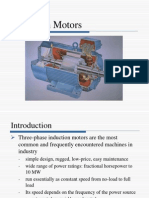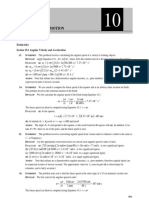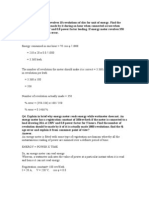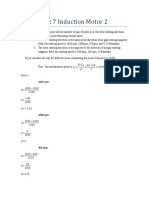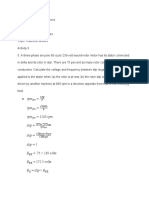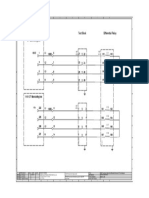Chapter 23 Three-Phase Induction Motors
Chapter 23 Three-Phase Induction Motors
Uploaded by
rowmanCopyright:
Available Formats
Chapter 23 Three-Phase Induction Motors
Chapter 23 Three-Phase Induction Motors
Uploaded by
rowmanOriginal Title
Copyright
Available Formats
Share this document
Did you find this document useful?
Is this content inappropriate?
Copyright:
Available Formats
Chapter 23 Three-Phase Induction Motors
Chapter 23 Three-Phase Induction Motors
Uploaded by
rowmanCopyright:
Available Formats
CHAPTER 23 THREE-PHASE INDUCTION MOTORS
Exercise 140, Page 393
1. The synchronous speed of a 3-phase, 4-pole induction motor is 60 rev/s. Determine the
frequency of the supply to the stator windings.
f 4
Synchronous speed, n s from which, frequency, f = n s p = 60 = 120 Hz
p 2
2. The synchronous speed of a 3-phase induction motor is 25 rev/s and the frequency of the supply
to the stator is 50 Hz. Calculate the equivalent number of pairs of poles of the motor.
f f 50
ns hence, number of pairs of poles, p = =2
p n s 25
3. A 6-pole, 3-phase induction motor is connected to a 300 Hz supply. Determine the speed of
rotation of the magnetic field produced by the stator.
f 300
Speed of rotation, n s = 100 rev/s
p 6
2
John Bird Published by Taylor and Francis 310
Exercise 141, Page 395
1. A 6-pole, 3-phase induction motor runs at 970 rev/min at a certain load. If the stator is connected
to a 50 Hz supply, find the percentage slip at this load.
f 50 50
Synchronous speed, n s = 16.667 rev/s
p 6 3
2
970
Rotor speed, n r = 16.167 rev/s
60
n nr 16.667 16.167
Hence, slip, s = s 100% 100% = 3%
ns 16.667
2. A 3-phase, 50 Hz induction motor has 8 poles. If the full load slip is 2.5%, determine (a) the
synchronous speed, (b) the rotor speed, and (c) the frequency of the rotor e.m.f.s.
f 50
(a) Synchronous speed, n s = 12.5 rev/s or 12.5 60 = 750 rev/min
p 8
2
n nr 12.5 n r
(b) Slip, s = s 100% i.e. 2.5 100%
ns 12.5
i.e.
2.512.5 12.5 n
r
100
and rotor speed, n r 12.5
2.512.5 = 12.5 0.3125
100
= 12.1875 rev/s or 12.1875 60 = 731 rev/min
(c) Since the synchronous speed is 12.5 rev/s and that of the rotor is 12.1876 rev/s, the rotating
magnetic field cuts the rotor bars at (12.5 12.1875), i.e. 0.3125 rev/s.
8
Thus, the frequency of e.m.f.s induced, f = n s p 0.3125 = 1.25 Hz
2
John Bird Published by Taylor and Francis 311
3. A three-phase induction motor is supplied from a 60 Hz supply and runs at 1710 rev/min when
the slip is 5%. Determine the synchronous speed.
ns nr 1710
Slip, s = and the rotor speed, n r = 28.5 rev/s
ns 60
5 n 28.5
Hence, s
100 ns
and 0.05 n s = n s - 28.5
i.e. 28.5 = n s - 0.05 n s = 0.95 n s
28.5
from which, synchronous speed, n s = = 30 rev/s or 30 60 = 1800 rev/min
0.95
4. A 4-pole, 3-phase, 50 Hz induction motor runs at 1440 rev/min at full load. Calculate (a) the
synchronous speed, (b) the slip and (c) the frequency of the rotor induced e.m.f.s.
f 50
(a) Synchronous speed, n s = 25 rev/s or 25 60 = 1500 rev/min
p 4
2
n nr 1440
(b) Slip, s = s 100% where n r = 24 rev/s
ns 60
25 24 100
i.e. slip, s = 100% = 4%
25 25
f 4
(c) n = or frequency of the rotor induced e.m.f.s, f = n p = (25 24) = 2 Hz
p 2
John Bird Published by Taylor and Francis 312
Exercise 142, Page 396
1. A 12-pole, 3-phase, 50 Hz induction motor runs at 475 rev/min. Calculate (a) the slip speed,
(b) the percentage slip and (c) the frequency of the rotor currents.
f 50 50
(a) Synchronous speed, n s = 8.3333 rev/s
p 12 6
2
475
Rotor speed, n r = 7.9167 rev/s
60
Hence, slip speed = n s n r = 8.3333 7.9167 = 0.4166 rev/s = 0.4166 60 = 25 rev/min
n nr 8.3333 7.9167
(b) Slip, s = s 100% 100% = 5%
ns 8.3333
(c) Frequency of the rotor currents, f r s f 0.05 50 = 2.5 Hz
2. The frequency of the supply to the stator of a 6-pole induction motor is 50 Hz and the rotor
frequency is 2 Hz. Determine (a) the slip, and (b) the rotor speed in rev/min.
(a) Rotor frequency, f r s f i.e. 2 = s(50)
2
from which, slip, s = = 0.04 or 4%
50
n nr f 50 50
(b) Slip, s = s where ns
ns p 6 3
2
from which, s ns ns n r
50
and rotor speed, n r n s s n s n s (1 s) 1 0.04
3
= 16 rev/s or 16 60 = 960 rev/min
John Bird Published by Taylor and Francis 313
Exercise 143, Page 398
1. The power supplied to a three-phase induction motor is 50 kW and the stator losses are 2 kW. If
the slip is 4%, determine (a) the rotor copper loss, (b) the mechanical power developed by the
rotor, (c) the output power of the motor if friction and windage losses are 1 kW, and (d) the
efficiency of the motor, neglecting rotor iron losses.
(a) Input power to rotor = stator input power stator losses
= 50 kW 2 kW = 48 kW
rotor copper loss 4 rotor copper loss
Slip = i.e.
rotor input 100 48
from which, rotor copper loss = (0.04)(48) = 1.92 kW
(b) Total mechanical power developed by the rotor = rotor input power rotor losses
= 48 1.92 = 46.08 kW
(c) Output power of the motor = power developed by the rotor friction and windage losses
= 46.08 1 = 45.08 kW
output power 45.08
(d) Efficiency, 100% 100% = 90.16%
input power 50
2. By using external rotor resistance, the speed of the induction motor in problem 1 is reduced to
40% of its synchronous speed. If the torque and stator losses are unchanged, calculate (a) the
rotor copper loss, and (b) the efficiency of the motor.
n nr n s 0.4 n s 0.6 n s
(a) Slip, s = s 100% 100% 100% = 60%
ns ns ns
Input power to rotor = 48 kW
rotor copper loss
Since slip, s = then rotor copper loss = s (rotor input)
rotor input
= 0.60(48) = 28.80 kW
John Bird Published by Taylor and Francis 314
(b) Power developed by rotor = input power to rotor rotor copper loss
= 48 28.80 = 19.20 kW
Output power of motor = power developed by rotor friction and windage losses
= 19.20 1 = 18.20 kW
output power 18.20
Hence, efficiency of motor, 100% 100%
input power 50
= 36.40%
John Bird Published by Taylor and Francis 315
Exercise 144, Page 400
1. A 400 V, three-phase, 50 Hz, 2-pole, star-connected induction motor runs at 48.5 rev/s on full
load. The rotor resistance and reactance per phase are 0.4 and 4.0 respectively, and the
effective rotor-stator turns ration is 0.8:1. Calculate (a) the synchronous speed, (b) the slip, (c) the
full load torque, (d) the power output if mechanical losses amount to 500 W, (e) the maximum
torque, (f) the speed at which maximum torque occurs, and (g) the starting torque.
f 50
(a) Synchronous speed, n s = 50 rev/s or 3000 rev/min
p 2
2
n nr 50 48.5 1.5
(b) Slip, s = s = 0.03 or 3%
ns 50 50
400
(c) Phase voltage, E1 = 230.94 V
3
N 2
m 2
N sE 2 R 3(0.8) 2 0.03(230.94)2 (0.4)
Full load torque, T = 1 2 1 2 2
2 n s
R s X
2(50) 0.4 2 0.03 4.0 2
2 2
639.9994
= (0.00611155) = 22.43 N m
0.1744
(d) Output power, including friction losses, Pm 2 n r T 2(48.5)(22.43) = 6835 W
Hence, output power = Pm - mechanical losses = 6835 500 = 6335 W or 6.34 kW
(e) Maximum torque occurs when R 2 X r 0.4
R 2 0.4
Slip, s = = 0.1
X 2 4.0
Hence, maximum torque,
s E 2R 0.01 230.94 2 0.4
Tm 0.00611155 2 1 2
(0.00611155)
R sX 2 0.4 2
0.4 2
2 2
2133.3331
= (0.00611155) = 40.74 N m
0.32
John Bird Published by Taylor and Francis 316
(f) For maximum torque, slip, s = 0.1
n nr 50 n r
Slip, s = s i.e. 0.1
ns 50
i.e. (0.1)(50) 50 n r and n r 50 (0.1)(50)
i.e. speed at which maximum torque occurs, n r 50 5 = 45 rev/s or 2700 rev/min
(g) At the start, i.e. at standstill, slip, s = 1
N 2
m 2
N E 2 R (230.94) 2 (0.4)
Hence, starting torque = 1 2 1 2 2 0.00611155 2
2 n s
2
2 R X 2
0.4 4.0
21333.31344
= (0.00611155)
16.16
= 8.07 N m
2. For the induction motor in Problem 1, calculate at full load (a) the rotor current, (b) the rotor
copper loss, and (c) the starting current.
N
s 2 E1
N1 0.03 0.8 230.94 5.54256
(a) Rotor current, I r = 13.27 A
R 2 2 sX 2 2 0.4 2 0.03 4.0 2 0.4176123
(b) Rotor copper loss per phase = Ir 2 R 2 13.27 0.4 = 70.44 W
2
Total rotor copper loss (for 3 phases) = 3 70.44 = 211.3 W
N2
E1
(c) Starting current, I 2 N1
0.8 230.94 = 45.96 A
R 2 2 X 2 2 0.42 4.02
John Bird Published by Taylor and Francis 317
3. If the stator losses for the induction motor in Problem 1 are 525 W, calculate at full load (a) the
power input, (b) the efficiency of the motor and (c) the current taken from the supply if the motor
runs at a power factor of 0.84
(a) Output power, Pm = 6835 W = 6.835 kW from (d) of problem 1
Rotor copper loss = 211.3 W = 0.2113 kW from (b) of problem 2
Stator input power, P1 Pm rotor copper loss rotor stator loss
= 6.833 + 0.2113 + 0.525 = 7.57 kW
(b) Net power output = 6.34 kW from (d) of problem 1
output power 6.34
Hence, efficiency of motor, 100% 100% = 83.75%
input power 7.57
(c) Power input, P1 3 VL IL cos where cos = power factor = 0.84
P1 7.57 1000
Hence, supply current, IL = 13.0 A
3 VL cos 3 400 0.84
4. For the induction motor in Problem 1, determine the resistance of the rotor winding required for
maximum starting torque.
Rotor reactance, X r s X 2 and at starting, slip, s = 1
Maximum torque occurs when rotor resistance, R 2 Xr s X2 X2 = 4.0
John Bird Published by Taylor and Francis 318
You might also like
- NC Solved ExamplesDocument4 pagesNC Solved ExamplesSubhash KorumilliNo ratings yet
- Chapman Electric Machinery Fundamentals 5th c2012 Solutions ISMDocument8 pagesChapman Electric Machinery Fundamentals 5th c2012 Solutions ISMRodrigo MartinsNo ratings yet
- Induction MachinesDocument81 pagesInduction Machinessandyarajagopalan321No ratings yet
- Chapter 23 Three-Phase Induction MotorsDocument9 pagesChapter 23 Three-Phase Induction MotorsisitestersNo ratings yet
- N P R/ PM: Table Speed For Motor / GeneratorDocument1 pageN P R/ PM: Table Speed For Motor / GeneratorGerald GribelNo ratings yet
- 5.4 Rotor E.M.F and Frequency: Example 5.1: The Stator of A 3-Phase, 4-Pole Induction Motor IsDocument6 pages5.4 Rotor E.M.F and Frequency: Example 5.1: The Stator of A 3-Phase, 4-Pole Induction Motor IsJOHN MINKHANTNo ratings yet
- Chapter 23Document10 pagesChapter 23Sherwin CaringalNo ratings yet
- Ee321 Example-Asynchronous-Examples1-1Document3 pagesEe321 Example-Asynchronous-Examples1-1Paulo MoreiraNo ratings yet
- Chapmanasenkron PDFDocument33 pagesChapmanasenkron PDFmuratNo ratings yet
- Chapter 7 Induction MotorsDocument34 pagesChapter 7 Induction MotorslalaNo ratings yet
- Páginas Desde (Solutions Manual) Electric Machinery 6ed Fitzgerald, Kingsley, UmanDocument3 pagesPáginas Desde (Solutions Manual) Electric Machinery 6ed Fitzgerald, Kingsley, UmanPedro LopezNo ratings yet
- Induction Machine PrinciplesDocument4 pagesInduction Machine PrinciplesshahanbashaNo ratings yet
- e = N (dΦ/dt) x 10: Generation of Alternating Electromotive ForceDocument8 pagese = N (dΦ/dt) x 10: Generation of Alternating Electromotive ForceReniel MendozaNo ratings yet
- Machine 2-ProblemDocument7 pagesMachine 2-ProblemJhonloyd Rosete LittauaNo ratings yet
- Rotational Kinematics Problems and SolutionsDocument9 pagesRotational Kinematics Problems and SolutionsBen CampanaroNo ratings yet
- Transformer and Induction MotorDocument55 pagesTransformer and Induction MotorEldeen EscuadroNo ratings yet
- DCACMACH Week 15Document6 pagesDCACMACH Week 15howlanddorrieNo ratings yet
- M10 Wolf57139 03 Se C10Document30 pagesM10 Wolf57139 03 Se C10c.s.kalkmanNo ratings yet
- 3 PhaseInductionMotors BookChapter 1Document19 pages3 PhaseInductionMotors BookChapter 1Rohan ShrivastavaNo ratings yet
- Machine 2 chapter 3Document63 pagesMachine 2 chapter 3yonasamare126No ratings yet
- Introduction To ELE Machine Work Sheet On Induction MotorDocument9 pagesIntroduction To ELE Machine Work Sheet On Induction MotorTSEGAAB NIGUSSENo ratings yet
- Induction MotorDocument6 pagesInduction MotorMuhamad NafianNo ratings yet
- Ac Single Phase First PartDocument32 pagesAc Single Phase First PartreyiNo ratings yet
- Ee 212 Ac Induction MotorsDocument9 pagesEe 212 Ac Induction MotorsabigabacNo ratings yet
- Ch10 Solution TotallyDocument32 pagesCh10 Solution TotallybiziaohaoNo ratings yet
- Angular Velocity BasicsDocument23 pagesAngular Velocity Basicsnsamkelo019No ratings yet
- Assignment 5 - Model AnswerDocument8 pagesAssignment 5 - Model Answerlwasd1234No ratings yet
- Electrical InstrumentsDocument19 pagesElectrical InstrumentsLakshmi Priya Palaniappan100% (1)
- Acdrives AssignDocument5 pagesAcdrives AssignRaja DesinguNo ratings yet
- Homework 7 - de La CruzDocument8 pagesHomework 7 - de La CruzAlvaro De La CruzNo ratings yet
- Speed Control of 3 Phase Induction Motor 1 Aim: Experiment No: 3Document10 pagesSpeed Control of 3 Phase Induction Motor 1 Aim: Experiment No: 3rohitkjNo ratings yet
- Download Study Resources for College Physics 10th Edition Young Solutions ManualDocument44 pagesDownload Study Resources for College Physics 10th Edition Young Solutions Manualhokwankuya100% (8)
- AD-DC MotorDocument7 pagesAD-DC MotorJay Mark BalaneNo ratings yet
- Chapter 2Document7 pagesChapter 2Shin Se Kyung100% (1)
- EE 205 Lecture 30Document14 pagesEE 205 Lecture 30Akshat SharmaNo ratings yet
- Three-Phase Induction Motor: Shadhon Chandra MohontaDocument16 pagesThree-Phase Induction Motor: Shadhon Chandra Mohontamonster promelNo ratings yet
- Chapter 4Document16 pagesChapter 4Randy MediNo ratings yet
- Hase Nduction Achines: Aculty of Ngineering NvironmentDocument10 pagesHase Nduction Achines: Aculty of Ngineering NvironmentMonika VaitulionytėNo ratings yet
- Polyphase Induction MotorDocument38 pagesPolyphase Induction MotorSaad KhaliqNo ratings yet
- Mo Grover SolutionDocument6 pagesMo Grover SolutionshretankprakashNo ratings yet
- HET 225 HEt 228 Tutorial 3 Solution S2 2014Document4 pagesHET 225 HEt 228 Tutorial 3 Solution S2 2014Ibrahim Hussain0% (1)
- Induction Motors Part 2 AC-DC MachineriesDocument7 pagesInduction Motors Part 2 AC-DC MachineriesAl Neo Pacino100% (1)
- Chapter 16Document19 pagesChapter 16Bengt HörbergNo ratings yet
- Ch6-Induction MachineDocument84 pagesCh6-Induction MachineVeli GörgülüNo ratings yet
- A. - B. Derive The Expression For Pitch Factore. CDocument8 pagesA. - B. Derive The Expression For Pitch Factore. CStream MarkusNo ratings yet
- Ceiling FANDocument16 pagesCeiling FANAtul ThakurNo ratings yet
- Energy ConversionDocument17 pagesEnergy ConversionEitch Ar100% (1)
- Synchronous GADocument44 pagesSynchronous GAKusalava SarmaNo ratings yet
- AC Machinery Fundamentals: 1.0 T To The Right 0.3 MDocument3 pagesAC Machinery Fundamentals: 1.0 T To The Right 0.3 Mmahindaamara321No ratings yet
- Soal UTS 2017Document6 pagesSoal UTS 2017Kukuh WidarsonoNo ratings yet
- Induction MotorDocument65 pagesInduction MotorAhmad Nawawi Ngah100% (1)
- Electrical Machine PracticalDocument11 pagesElectrical Machine PracticalOyetayo Muhammad Jamiu olamideNo ratings yet
- Determining Rotor Leakage ReactanceDocument5 pagesDetermining Rotor Leakage ReactanceGaspar RodríguezNo ratings yet
- Induction MotorsDocument24 pagesInduction MotorsJaniel MalitNo ratings yet
- Solucion Cap 4 ChapmanDocument6 pagesSolucion Cap 4 ChapmanEduardo Llanos CruzNo ratings yet
- Electricity in Fish Research and Management: Theory and PracticeFrom EverandElectricity in Fish Research and Management: Theory and PracticeNo ratings yet
- Advanced Electric Drives: Analysis, Control, and Modeling Using MATLAB / SimulinkFrom EverandAdvanced Electric Drives: Analysis, Control, and Modeling Using MATLAB / SimulinkNo ratings yet
- Enhanced Oil Recovery: Resonance Macro- and Micro-Mechanics of Petroleum ReservoirsFrom EverandEnhanced Oil Recovery: Resonance Macro- and Micro-Mechanics of Petroleum ReservoirsRating: 5 out of 5 stars5/5 (1)
- 3D Modeling of Nonlinear Wave Phenomena on Shallow Water SurfacesFrom Everand3D Modeling of Nonlinear Wave Phenomena on Shallow Water SurfacesNo ratings yet
- Project For InternshipDocument63 pagesProject For Internshiptewele100% (1)
- ADIGRAT UNIVERSITY - Fikadu.finsh - by NegasiDocument18 pagesADIGRAT UNIVERSITY - Fikadu.finsh - by NegasiteweleNo ratings yet
- Demineralized Process Water..Document52 pagesDemineralized Process Water..teweleNo ratings yet
- Twe (1) ReportasDocument69 pagesTwe (1) ReportasteweleNo ratings yet
- Cement (Chapter 3)Document13 pagesCement (Chapter 3)teweleNo ratings yet
- Lecture - 1 For Process Industries OneDocument37 pagesLecture - 1 For Process Industries OneteweleNo ratings yet
- Constructional Futures of BoilersDocument2 pagesConstructional Futures of BoilersteweleNo ratings yet
- Beer Production L-3Document16 pagesBeer Production L-3teweleNo ratings yet
- Corrosion: 1, Breakdown Maintenance and Unscheduled BreakdownsDocument4 pagesCorrosion: 1, Breakdown Maintenance and Unscheduled BreakdownsteweleNo ratings yet
- Wine Production L 4Document16 pagesWine Production L 4teweleNo ratings yet
- Penicillin L-5Document17 pagesPenicillin L-5teweleNo ratings yet
- Tagb PDFDocument2 pagesTagb PDFteweleNo ratings yet
- Evaluation Questions For Chemical Engineering Internship: Water TreatmentDocument2 pagesEvaluation Questions For Chemical Engineering Internship: Water TreatmentteweleNo ratings yet
- Evaluation Questions For Chemical Engineering Internship: Water TreatmentDocument2 pagesEvaluation Questions For Chemical Engineering Internship: Water TreatmentteweleNo ratings yet
- Chapter One: 1.1 BackgroundDocument22 pagesChapter One: 1.1 BackgroundteweleNo ratings yet
- Mebrhit GebremariamDocument80 pagesMebrhit GebremariamteweleNo ratings yet
- Evaluation Questions For Chemical Engineering Internship: Water TreatmentDocument2 pagesEvaluation Questions For Chemical Engineering Internship: Water TreatmentteweleNo ratings yet
- Chapter One: 1.1 BackgroundDocument19 pagesChapter One: 1.1 BackgroundteweleNo ratings yet
- Chapter One: 1.1 BackgroundDocument2 pagesChapter One: 1.1 BackgroundteweleNo ratings yet
- Plug Flow Reactor DesignDocument3 pagesPlug Flow Reactor DesignteweleNo ratings yet
- Cable Size Calculations SpreadsheetDocument4 pagesCable Size Calculations SpreadsheetPradip ShindeNo ratings yet
- Booster TransformerDocument2 pagesBooster TransformerShivam JhaNo ratings yet
- MM MCBDocument4 pagesMM MCBHarsh SainiNo ratings yet
- Operation Manual of Overhead Crane EnglishDocument21 pagesOperation Manual of Overhead Crane EnglishParthiban Karuna83% (6)
- Solution For Battery Charging of Agricultural DroneDocument2 pagesSolution For Battery Charging of Agricultural DroneZain Ul AbedinNo ratings yet
- Achieving High Performance With Heft Analytics - AccentureDocument20 pagesAchieving High Performance With Heft Analytics - AccentureSweta DeyNo ratings yet
- Smart Optimization in Battery Energy Storage Systems An OverviewDocument17 pagesSmart Optimization in Battery Energy Storage Systems An OverviewAsmZziz Oo100% (2)
- HBXX 6516DS VTM - HBXX 6516DS A2mDocument3 pagesHBXX 6516DS VTM - HBXX 6516DS A2mBadru SalamNo ratings yet
- SIEMENS Coordinación de ProtecciónDocument32 pagesSIEMENS Coordinación de Protecciónarturoelectrica100% (1)
- Cdg11 16Document10 pagesCdg11 16keith_homeNo ratings yet
- 2006 Bookmatter AnalogDesignEssentialsDocument5 pages2006 Bookmatter AnalogDesignEssentialsgarbagepatchNo ratings yet
- Generator Testing Project ReportDocument95 pagesGenerator Testing Project ReportSindhu ManchukondaNo ratings yet
- Data Sheet: PG150R PG1510RDocument2 pagesData Sheet: PG150R PG1510RJOHN BRICCO A. MATACSILNo ratings yet
- A.C. Static Watthour Meters, Class 1 and 2 - Specification: Indian StandardDocument38 pagesA.C. Static Watthour Meters, Class 1 and 2 - Specification: Indian StandardKartikeya SharmaNo ratings yet
- Carvin Schematic - DCM2500 Rev BDocument1 pageCarvin Schematic - DCM2500 Rev Bdod0% (2)
- SML Series Pressure SensorDocument2 pagesSML Series Pressure Sensorkishan1234No ratings yet
- IOM 200 Data Sheet 4921240366 UKDocument10 pagesIOM 200 Data Sheet 4921240366 UKNarendra NarukaNo ratings yet
- Thevenin ReportDocument7 pagesThevenin ReportMohamed KamilNo ratings yet
- Haryana Power Generation Corporation Limited: Vikas K. Gupta, Sr. A. O./ RegDocument38 pagesHaryana Power Generation Corporation Limited: Vikas K. Gupta, Sr. A. O./ RegBabu Aravind100% (1)
- KBJL2211030017 (BJ1 Sbin) (Wl-Dbs5900-Gul-New-Ado004 Ok) 20221104185150Document10 pagesKBJL2211030017 (BJ1 Sbin) (Wl-Dbs5900-Gul-New-Ado004 Ok) 20221104185150AVENON MardocheeNo ratings yet
- Infineon TLE8386 DS v01 - 00 enDocument32 pagesInfineon TLE8386 DS v01 - 00 enbetodias30No ratings yet
- CV of Lesego Masigo 1Document4 pagesCV of Lesego Masigo 1Lesego MasigoNo ratings yet
- Tta Study MaterialDocument18 pagesTta Study Materialasheokand172No ratings yet
- 5989 8853enDocument31 pages5989 8853enkumbrovNo ratings yet
- Lixise lxc6310Document33 pagesLixise lxc6310Hector CabreraNo ratings yet
- AE.23072022.Potential Difference, Resistance and Current AnswersDocument2 pagesAE.23072022.Potential Difference, Resistance and Current AnswersĐặng Thái Nhật100% (1)
- Point A: SPA-400 - King KMA 20 Audio Panel Installation Wiring DiagramDocument1 pagePoint A: SPA-400 - King KMA 20 Audio Panel Installation Wiring DiagramAdrian TodeaNo ratings yet
- TL494Document8 pagesTL494bianny6269No ratings yet
- Landis+Gyr E850: Grid MeteringDocument6 pagesLandis+Gyr E850: Grid MeteringmetrofireNo ratings yet
- RP4 Drawing-Model11-1 PDFDocument1 pageRP4 Drawing-Model11-1 PDFmuhammad usmanNo ratings yet


